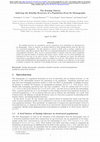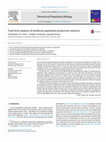Papers by Christophe F D Coste

The familial structure of a population and the relatedness of its individuals are determined by i... more The familial structure of a population and the relatedness of its individuals are determined by its demography. There is, however, no general method to infer kinship directly from the life-cycle of a structured population. Yet this question is central to fields such as ecology, evolution and conservation, especially in contexts where there is a strong interdependence between familial structure and population dynamics. Here, we give a general formula to compute, from any matrix population model, the expected number of arbitrary kin (sisters, nieces, cousins, etc) of a focal individual ego, structured by the class of ego and of its kin. Central to our approach are classic but little-used tools known as genealogical matrices, which we combine in a new way. Our method can be used to obtain both individual-based and population-wide metrics of kinship, as we illustrate. It also makes it possible to analyze the sensitivity of the kinship structure to the traits implemented in the model.

• A novel method for building multitrait population projection matrices is proposed. • Asymptotic... more • A novel method for building multitrait population projection matrices is proposed. • Asymptotic properties of multitrait matrices are explored. • A new evolutionary demography tool, the trait level analysis, is proposed. • Trait level analysis sheds light on effect of traits on multitrait dynamics. • A parity–fertility–fecundity model reveals the potential of trait level analysis. a b s t r a c t In most matrix population projection models, individuals are characterized according to, usually, one or two traits such as age, stage, size or location. A broad theory of multitrait population projection matrices (MPPMs) incorporating larger number of traits was long held back by time and space computational complexity issues. As a consequence, no study has yet focused on the influence of the structure of traits describing a life-cycle on population dynamics and life-history evolution. We present here a novel vector-based MPPM building methodology that allows to computationally-efficiently model populations characterized by numerous traits with large distributions, and extend sensitivity analyses for these models. We then present a new method, the trait level analysis consisting in folding an MPPM on any of its traits to create a matrix with alternative trait structure (the number of traits and their characteristics) but similar asymptotic properties. Adding or removing one or several traits to/from the MPPM and analyzing the resulting changes in spectral properties, allows investigating the influence of the trait structure on the evolution of traits. We illustrate this by modeling a 3-trait (age, parity and fecundity) population designed to investigate the implications of parity–fertility trade-offs in a context of fecundity heterogeneity in humans. The trait level analysis, comparing models of the same population differing in trait structures, demonstrates that fertility selection gradients differ between cases with or without parity–fertility trade-offs. Moreover it shows that age-specific fertility has seemingly very different evolutionary significance depending on whether heterogeneity is accounted for. This is because trade-offs can vary strongly in strength and even direction depending on the trait structure used to model the population.
Books by Christophe F D Coste
A l’instar de Roland Barthes, qui partait du principe que le nom propre est le « prince des signi... more A l’instar de Roland Barthes, qui partait du principe que le nom propre est le « prince des signifiants », déclarant avoir pensé « que la réussite d’un roman tenait à la réussite de son onomastique », Dumont démontre à travers son oeuvre l’importance qu’il accorde à la désignation de ses personnages. En cela il se place comme légataire des auteurs de roman en vers, français, des xiie et xiiie siècles dans lesquels le jeu des « désignateurs » – au-delà donc du simple nom propre – « reflète, sélectionne et réoriente les enjeux principaux de l’intrigue ». Plus près de nous, Bruno Dumont émerge surtout comme héritier des romanciers du xixe siècle, pour qui l’onomaturgie – ou formation des anthroponymes – est un processus clef de la production romanesque.





Uploads
Papers by Christophe F D Coste
Books by Christophe F D Coste